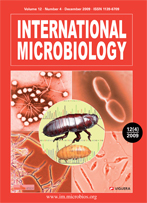Identification of Sinorhizobium (Ensifer) medicae based on a specific genomic sequence unveiled by M13-PCR fingerprinting
Keywords:
Sinorhizobium (Ensifer) medicae, Medicago polymorpha L., rhizobia, nitrogen-fixing nodules, M13-PCR fingerprintingAbstract
A collection of nodule isolates from Medicago polymorpha obtained from southern and central Portugal was evaluated by M13-PCR fingerprinting and hierarchical cluster analysis. Several genomic clusters were obtained which, by 16S rRNA gene sequencing of selected representatives, were shown to be associated with particular taxonomic groups of rhizobia and other soil bacteria. The method provided a clear separation between rhizobia and co-isolated non-symbiotic soil contaminants. Ten M13-PCR groups were assigned to Sinorhizobium (Ensifer) medicae and included all isolates responsible for the formation of nitrogen-fixing nodules upon re-inoculation of M. polymorpha test-plants. In addition, enterobacterial repetitive intergenic consensus (ERIC)-PCR fingerprinting indicated a high genomic heterogeneity within the major M13-PCR clusters of S. medicae isolates. Based on nucleotide sequence data of an M13-PCR amplicon of ca. 1500 bp, observed only in S. medicae isolates and spanning locus Smed_3707 to Smed_3709 from the pSMED01 plasmid sequence of S. medicae WSM419 genome’s sequence, a pair of PCR primers was designed and used for direct PCR amplification of a 1399-bp sequence within this fragment. Additional in silico and in vitro experiments, as well as phylogenetic analysis, confirmed the specificity of this primer combination and therefore the reliability of this approach in the prompt identification of S. medicae isolates and their distinction from other soil bacteria. [Int Microbiol 2009; 12(4):215-225]Downloads
Published
2010-01-21
Issue
Section
Research Articles
License
Submission of a manuscript to International Microbiology implies: that the work described has not been published before, including publication in the World Wide Web (except in the form of an Abstract or as part of a published lecture, review, or thesis); that it is not under consideration for publication elsewhere; that all the coauthors have agreed to its publication. The corresponding author signs for and accepts responsability for releasing this material and will act on behalf of any and all coauthors regarding the editorial review and publication process.If an article is accepted for publication in International Microbiology, the authors (or other copyright holder) must transfer to the journal the right–not exclusive–to reproduce and distribute the article including reprints, translations, photographic reproductions, microform, electronic form (offline, online) or any other reproductions of similar nature. Nevertheless, all article in International Microbiology will be available on the Internet to any reader at no cost. The journal allows users to freely download, copy, print, distribute, search, and link to the full text of any article, provided the authorship and source of the published article is cited. The copyright owner's consent does not include copying for new works, or resale. In these cases, the specific written permission of International Microbiology must first be obtained.
Authors are requested to create a link to the published article on the journal's website. The link must be accompanied by the following text: "The original publication is available on LINK at <http://www.im.microbios.org>. Please use the appropiate URL for the article in LINK. Articles disseminated via LINK are indexed, abstracted, and referenced by many abstracting and information services, bibliographic networks, subscription agencies, library networks, and consortia.




